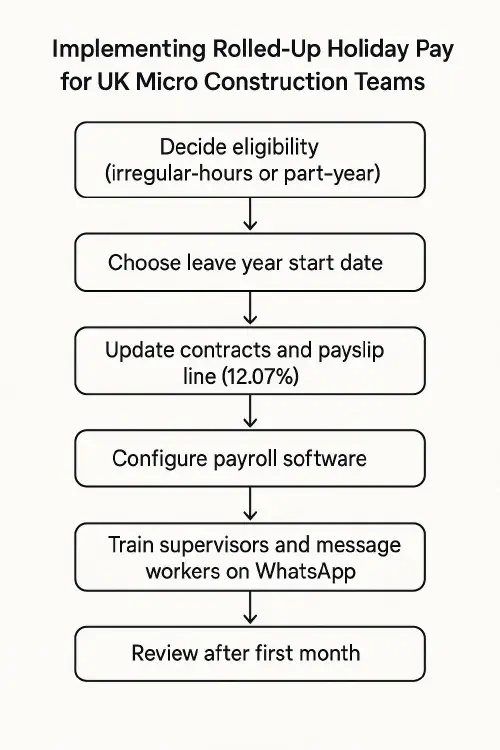
Hiring, Training & HR
Rolled-up holiday pay for trades: who it applies to, 12.07 percent calculator and payslip wording
TrainAR Team
26 days ago
5 min read
Rolled-up holiday pay for trades: who it applies to, 12.07 percent calculator and payslip wording
Category: Hiring, Training & HR • Niche: Payroll, irregular-hours workers, zero-hours, agency labour, Working Time Regulations

UK construction office desk with payslip showing rolled-up holiday pay 12.07 percent
Contents
- Quick answer
- Who this is for
- What changed in 2024 and when it kicks in for you
- Who you can use rolled-up pay for
- How to calculate 12.07 percent correctly
- Payslip wording that keeps you compliant
- Set it up in payroll software
- WhatsApp rollout plan for your team
- Common pitfalls and how to avoid them
- FAQ
Quick answer
- Rolled-up holiday pay lets you add holiday pay to each wage packet instead of paying when time off is taken. From leave years starting on or after 1 April 2024, it’s lawful for irregular-hours and part-year workers only, if you show it as a separate line on payslips and calculate it at least at 12.07 percent of pay for work done in the period. See the formal guidance on GOV.UK and Acas.
Who this is for
- Owners, site managers and payroll admins in small UK construction firms using zero-hours, agency labour, or variable-shift operatives.
- Anyone trying to tidy up payslips, stay compliant with Working Time Regulations, and avoid disputes about holiday accruals.
What changed in 2024 and when it kicks in for you
- The law took effect 1 January 2024, but rolled-up pay and the new accrual method apply for leave years starting on or after 1 April 2024. If your leave year runs January to December, these parts start for you on 1 January 2025.
- Statutory entitlement is still up to 5.6 weeks. For irregular-hours and part-year workers it accrues at 12.07 percent of hours worked each pay period. Details and examples are on GOV.UK.
Who you can use rolled-up pay for
- Irregular-hours worker: under the contract, paid hours in each pay period are wholly or mostly variable.
- Part-year worker: works only part of the year with at least a week of unpaid time when not required to work.
- Not for people with regular hours all year.
How to calculate 12.07 percent correctly
- Simple method per pay period: Rolled-up holiday pay = 12.07 percent × total pay for work done in the period.
- Example weekly calc: Operative earns £720 for hours worked. Holiday uplift = 720 × 0.1207 = £86.90. Payslip shows both.
- If the worker is on sick or family leave, the guidance uses an average from a relevant reference period. See GOV.UK for the treatment during non-working periods.
Payslip wording that keeps you compliant
Itemise rolled-up holiday as its own line.
- Recommended label: “Rolled-up holiday pay (12.07 percent)”
- Optional breakdown: show hours and the calculated amount.
- Make sure the payslip total clearly separates normal pay, rolled-up holiday pay, and deductions.
- Sources confirming separate itemisation: Acas, DavidsonMorris.

Simple flow showing how to implement rolled-up holiday pay in a micro construction business
Set it up in payroll software
- Add an earning type called “Rolled-up holiday pay” at 12.07 percent of gross for the period. Most UK payroll systems allow an addition formula; test with one worker first.
- Ensure PAYE and National Insurance apply because it’s earnings. See Low Incomes Tax Reform Group for tax treatment.
- Keep your 5.6 weeks entitlement records. If you roll up, you still need to encourage leave and track days taken for health and safety.
WhatsApp rollout plan for your team
- Message template to workers: “From [DATE] we’ll show rolled-up holiday pay as a separate line at 12.07 percent for irregular/part-year roles. Your overall entitlement stays the same. Shout if you want help planning time off.”
- Supervisors briefing: “You still need to approve holidays in the rota and make sure operatives take breaks over the year. Rolled-up pay does not remove the right to time off.”
Common pitfalls and how to avoid them
- Using rolled-up pay for regular-hours staff. Avoid: assess contracts first.
- Hiding the amount inside the hourly rate. Avoid: itemise on payslips.
- Forgetting that the first application date depends on your leave year. Avoid: write it in your policy and payroll calendar.
- Not meeting National Minimum Wage. Rolled-up pay cannot be used to top up to minimum wage.
- Poor comms. Use simple WhatsApp messages and update contracts to avoid confusion.
FAQ
Is 12.07 percent always correct?
- It’s the statutory method for irregular-hours and part-year workers in leave years beginning on or after 1 April 2024. If your operatives have regular hours, don’t use the rolled-up route.
Do we tax rolled-up holiday pay?
- Yes. It’s treated as normal earnings for PAYE and NICs. See this explanation from the Low Incomes Tax Reform Group.
Does rolled-up pay count towards minimum wage?
- You cannot use rolled-up holiday pay to top up to National Minimum Wage. Workers must meet NMW on their basic pay alone.
What if my leave year starts in January?
- The rolled-up option applies from the first leave year that begins on or after 1 April 2024. For a Jan–Dec leave year, that means 1 January 2025.
Do I still need to track and encourage time off?
- Yes. Even with rolled-up pay you must make sure workers can and do take their entitlement over the year.
Want to slash training times and increase revenue per Engineer? Join our Waitlist: https://trainar.ai/waitlist